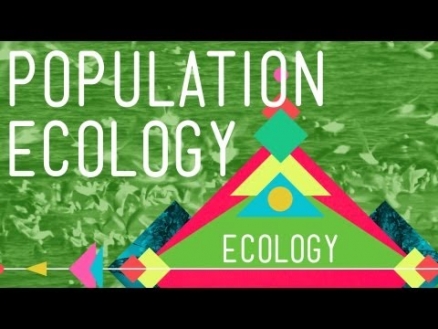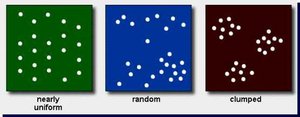Population ecology

Population ecology is the field of ecology that focuses on the factors that affect the population size of a given organism, population growth rate, and spatial dispersion of individuals with populations. Demography is the subset of population ecology that studies statistics related to human populations.
Contents
Factors affecting population size
The only factors that can alter population sizes are births, deaths, immigration, and emigration. Births and immigration add individuals to a population whereas deaths and emigration remove individuals from a population. When more individuals are being added to a population than are being removed, the population increases in size. Alternatively, when more individuals are removed from the population than are added to the population the population decreases in size. Population sizes do not change when the rate that individuals are lost from a population is equal to the rate that individuals are added to the population (dynamic equilibrium).
Factors affecting population growth rates
Population growth rates are affected by interactions with both the abiotic and biotic environment. Climactic factors such as precipitation and temperature can have profound direct and indirect effects on population sizes. Temporal fluctuations in abiotic conditions can be important causes of variation in population sizes. Biotic factors such as competition and predation can directly and indirectly affect population sizes. Population dynamics can be influenced by interactions with members of their own species (e.g., intraspecific competition) and members of different species (e.g., interspecific competition, predation, and mutualism).
Models of population growth
Population ecologists have developed mathematical models to study the growth of populations. The simplest model of population growth is the exponential growth model which assumes that the per capita growth rate (the change in population size/time/individual) is constant. Because populations growing exponentially continue to grow at an increasing rate, the exponential growth model is not a realistic model for most populations.
The logistic growth model is a more realistic model because it allows the per capita growth rate to vary with population size. The carrying capacity, the population size at which the population growth rate equals zero, is reached when the per capita birth rate (# births/time/individual) equals the per capita death rate (# deaths/time/individual). In logistic growth, birth and death rates are density dependent; as populations increase in size the per capita birth rate decreases (due to increased competition for resources) and the per capita death rate increases due to increased competition for resources, the increased spread of disease or an increase in predation that arises when predators are attracted to areas of high population sizes.
In the real world patterns of population growth may be more complicated than predicted by simple models because most populations are regulated by a variety of density dependent (e.g., competition and spread of disease) and density independent factors (e.g., climate and disturbances).
Spatial dispersion

Individuals in a population may be spread across the environment in different patterns (clumped dispersion, even dispersion, or random dispersion). Interaction with both the abiotic and biotic environments can influence patterns of spatial dispersion. For example, clumped dispersions may arise when individuals are limited to living in patchy with the appropriate abiotic environmental conditions and even dispersions may arise as the result of intraspecific competition.
Human population growth
The study of human population growth is an especially important subset of the field of population ecology. Humans have had a unique pattern of population growth. Human demographers are interested in the factors that cause patterns to vary between different countries and predicting what will happen to human population growth in the future.
See also
Further reading
- ** Campbell, N.A., J.B. Reece, and L.G. Mitchell. 2006. Biology. Addison Wesley Longman, Inc. Menlo Park, CA. ISBN: 080537146X
- Raven, P.H., G.B. Johnson, J.B. Losos, K.A. Mason, and S.R. Singer. 2008. Biology, 8th edition. McGraw Hill, New York, NY. ISBN: 0073227390